
20-30 е
.pdf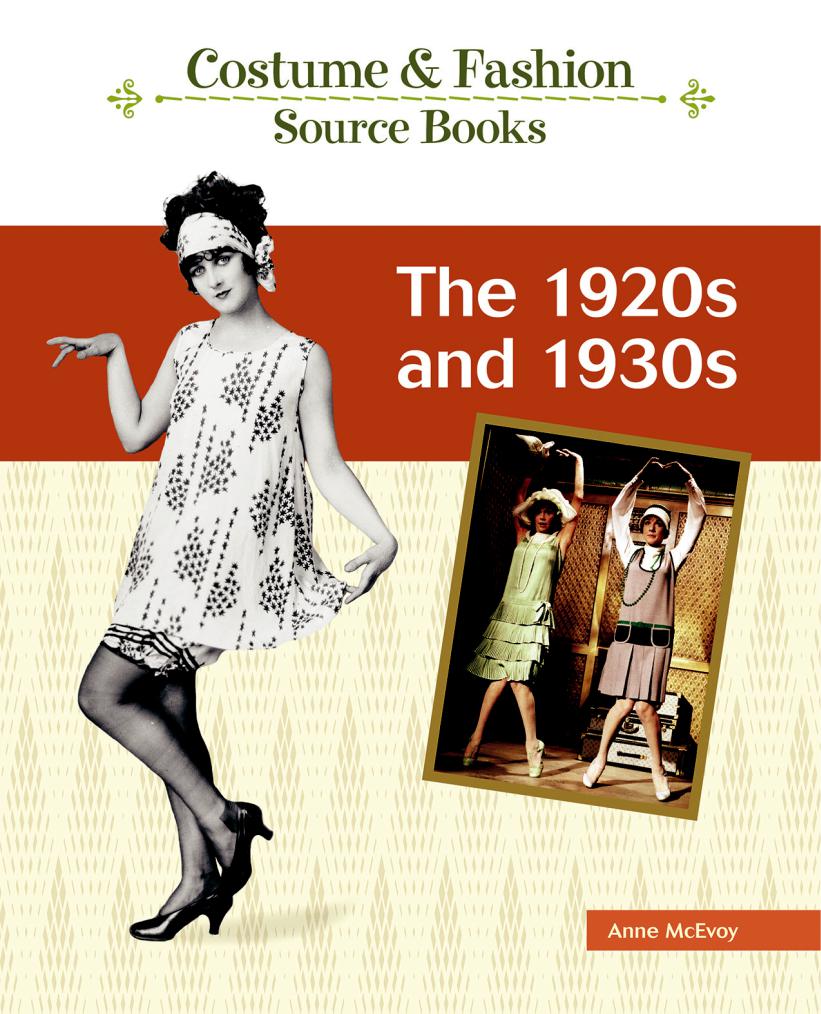
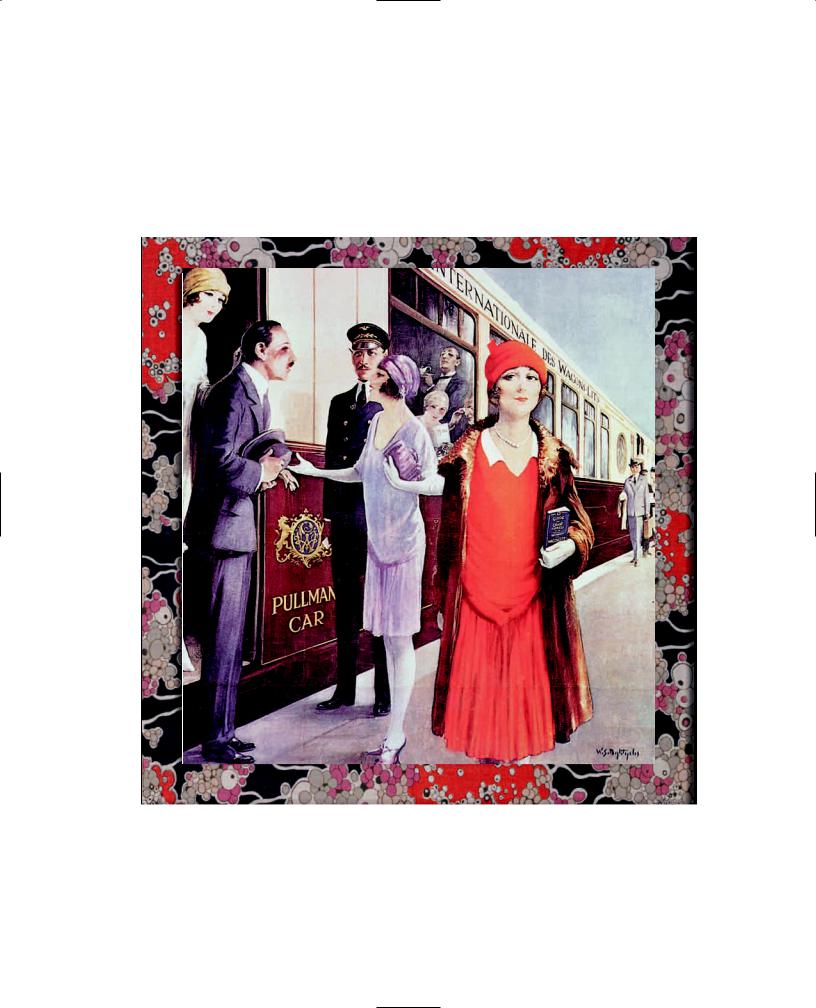
C O S T U M E A N D F A S H I O N S O U R C E B O O K S
The 1920s and 1930s
Anne McEvoy
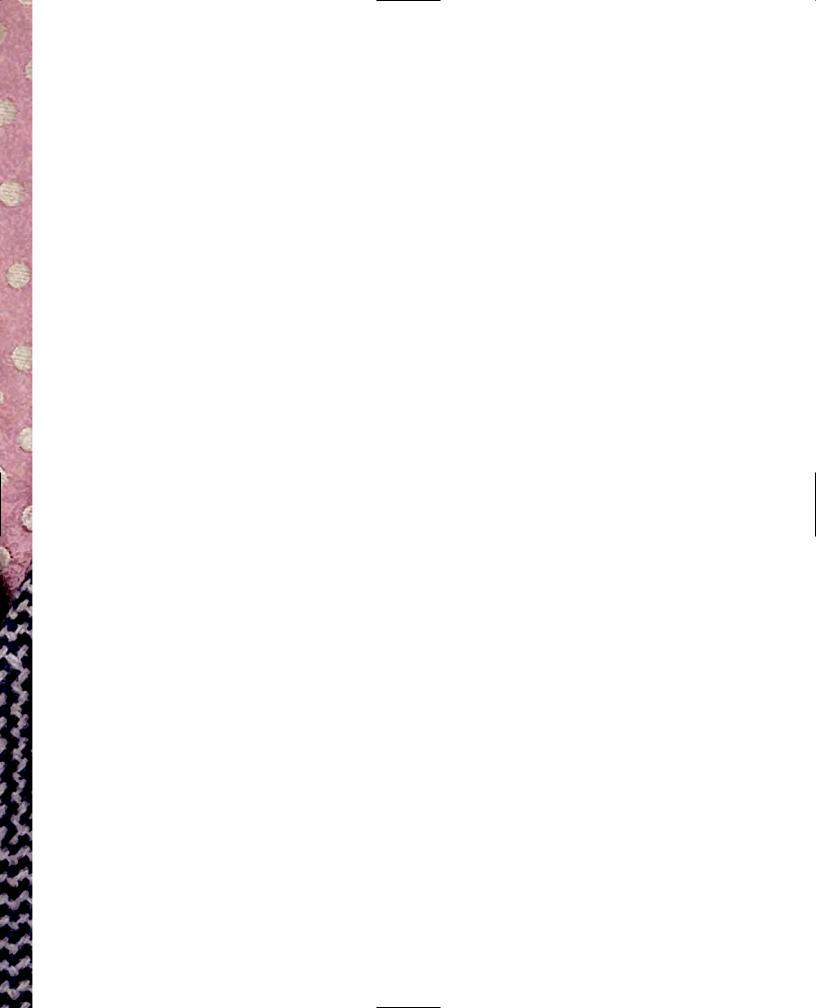
Copyright © 2009 Bailey Publishing Associates Ltd
Produced for Chelsea House by Bailey Publishing Associates Ltd, 11a Woodlands, Hove BN3 6TJ, England
Project Manager: Patience Coster
Text Designer: Jane Hawkins
Picture Research: Shelley Noronha
Artist: Deirdre Clancy Steer
All rights reserved. No part of this book may be reproduced or utilized in any form or by any means, electronic or mechanical, including photocopying, recording, or by any information storage or retrieval systems, without permission in writing from the publisher. For information contact:
Chelsea House
An imprint of Infobase Publishing 132 West 31st Street
New York, NY 10001
Library of Congress Cataloging-in-Publication Data McEvoy, Anne.
The 1920s and 1930s / Anne McEvoy.
p. cm. -- (Costume and fashion source books) Includes index.
ISBN 978-1-60413-383-7
1. Clothing and dress--History--20th century--Juvenile literature. 2. Dress accessories--History--20th century--Juvenile literature. 3. Nineteen twenties-- Juvenile literature. 4. Nineteen thirties--Juvenile literature. I. Title.
GT596.M385 2009 391.009’04--dc22
2009001236
Chelsea House books are available at special discounts when purchased in bulk quantities for businesses, associations, institutions, or sales promotions. Please call our Special Sales Department in New York on (212) 967-8800 or (800) 322-8755. You can find Chelsea House on the World Wide Web at: http://www.chelseahouse.com.
Printed and bound in China
10 9 8 7 6 5 4 3 2 1
The publishers would like to thank the following for permission to reproduce their pictures: Art Archive: 13left (Bibliothèque des Arts Décoratifs Paris/Gianni Dagli Orti), 14 (Culver Pictures), 20, 26 andtitle page (Private Collection/Gianni Dagli Orti), 28, 48 detail, 58 (Eileen Tweedy); Bailey Publishing Associates Ltd: contents page and 13 right, 30 left; Corbis: 15 (Bettmann), 22 (Underwood & Underwood), 24 (John Springer Collection), 32 (Bettmann), 35 (Condé Nast Archive), 39 (Michael Childers/Sygma), 48 (Condé Nast Archive), 49 (Bettmann), 54 (CinemaPhoto), 59 (Condé Nast
Archive); Kobal Collection: 10 (Universal), 19 (Paramount), 23, 29, 30right (United Artists), 36, 40 detail, 42 (MGM), 43, 44, 45 (Clarence Sinclair Bull), 46, 47 (Magnolia/Sweetland/John Clifford), 53 (Warner Bros.); Mary Evans Picture Library: 5 (Illustrated London News), 6, 11 (Illustrated London News), 12, 16, 18 (Illustrated London News), 18detail, 25, 27, 31, 34, 38, 50 (Anthony Lipmann), 52 (Illustrated London News), 57 (John Maclellan); Rex Features: 37, 51; Topfoto: 40; Victoria and Albert Museum: 6detail, 7, 8, 14 detail, title page detail and 28 detail, 36 detail, 41, 56 (all V & A Images).
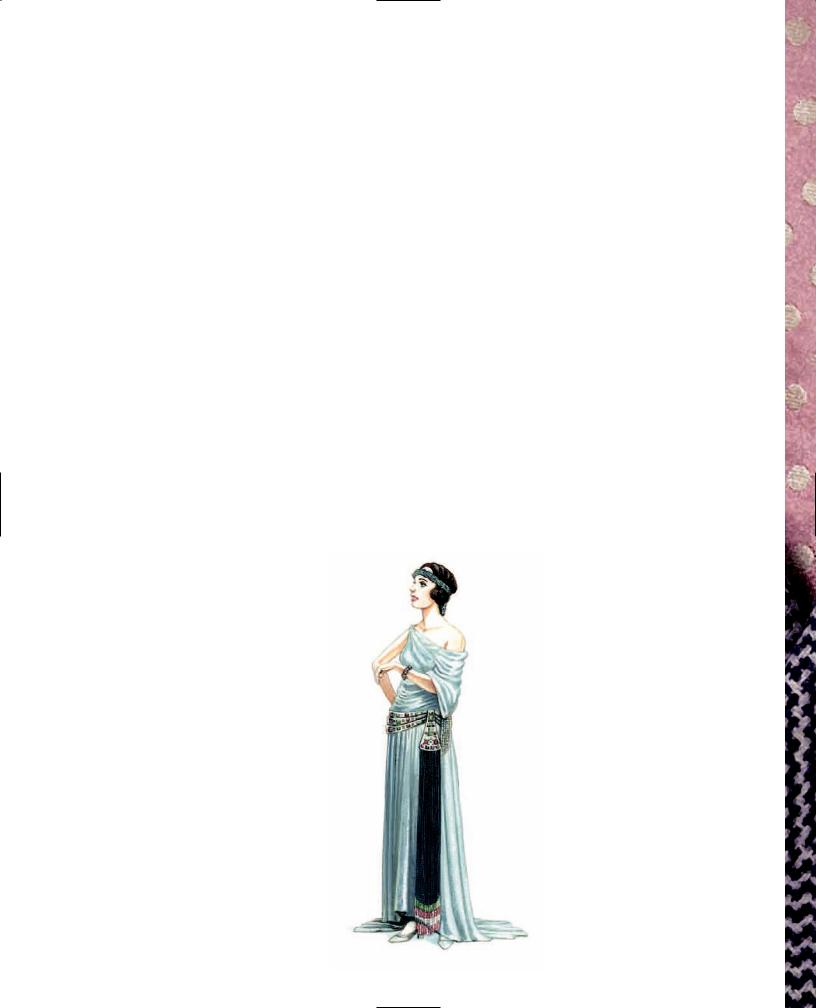
Contents
Introduction |
5 |
Chapter 1: New Clothes for a New Age |
6 |
Chapter 2: Gentlemen and Gangsters |
14 |
Chapter 3: 1920s Casual and Day Wear |
18 |
Chapter 4: 1930s Women’s Wear |
28 |
Chapter 5: 1930s Men’s Wear |
36 |
Chapter 6: The Golden Age of Glamour |
40 |
Chapter 7: 1930s Day Wear, Sportswear, |
|
and Children’s Wear |
48 |
Glossary |
60 |
Further Information |
61 |
Source List |
62 |
Index |
64 |

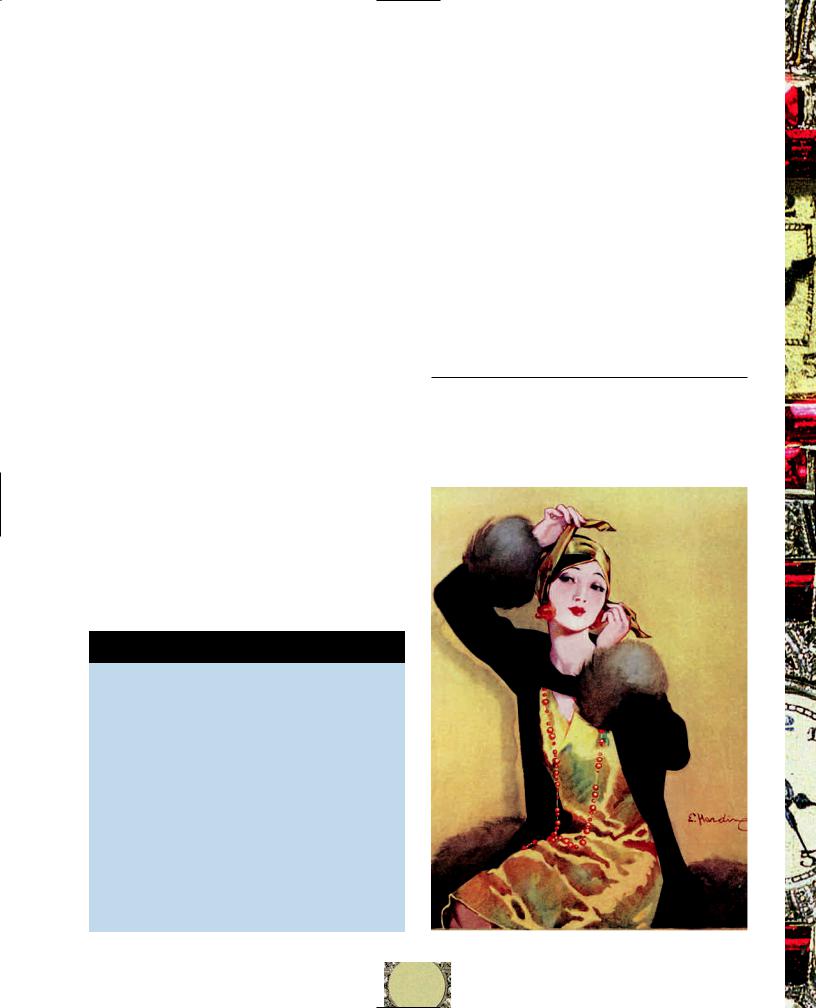
Introduction
Although the 1920s and 1930s are often lumped together as the period “between the wars,” the two decades were quite different in character and styles of dress varied greatly.
The 1920s were the Jazz Age, a period of escapism after the horrors of World War I. The younger generation, especially, turned their backs on the formality and dark, buttoned-up clothing of the previous century. On both sides of the Atlantic, life was now fun, one seemingly endless party. With Europe still recovering from the war and repaying debts, the United States took the lead
in new technology. Mass manufacturing made consumer goods cheaper and more accessible. New fabrics seemed to be invented every week— rayon, known as “art silk,” nylon, and many more.
In 1929, the Wall Street stock market crash brought the age of reckless partying to an abrupt end.
The 1930s began with a widespread economic depression and unemployment and ended with the world at war again. It was a sober period, albeit with welcome touches of glamour for some.
A R T D E C O
The Exhibition of Modern Decorative and Industrial Arts, held in Paris in 1925, spawned the term art deco, an artistic style that dominated the late 1920s and the 1930s. Based on geometric shapes and strong colors and inspired by African and other ethnic
arts as well as up-to-the-minute technological developments in speed and travel, it influenced everything from architecture and interior design to fashion. Typical shapes are angular stepped blocks, sunbursts, diagonals, and chevrons, but sweeping, streamlined curves are also much in evidence.
This text brings together some of the most popular styles and dominant trends of the 1920s and 1930s and demonstrates how to achieve the look—from free-spirited flapper to Clark Gable look-alike. Some period pieces can still be found in thrift shops and secondhand sales. Others can be tracked down via the Internet, where auction sites often have vintage pieces selling for low prices. Other items you can make quite simply. Since the 1970s, there have been several revivals of elements of 1920s and 1930s fashions, and these more modern pieces make acceptable substitutes.
Below: This classic outfit from 1929, in black and gold and featuring a bandeau headdress, captures the moment at which the madness of the 1920s began to settle down into the elegance of the 1930s.
5

T H E A L G O N Q U I N R O U N D TA B L E
This was a celebrated group of writers and critics who met every day for lunch at the Algonquin Hotel in New York City to discuss everything from fashion to politics and theater. Members included humorist Robert Benchley; Harold Ross, editor of The New Yorker; novelist Edna Ferber; playwrights George S. Kaufman and Alexander Woollcott; and poet and critic Dorothy Parker. They referred to themselves as “the Vicious Circle” because of their barbed jokes and witty gossip.
C H A P T E R 1
New Clothes for a New Age
Above: A flapper in a shockingly short dr ess grabs a ride on the backseat of her beau’s bike, indulging the Jazz Age’s taste for speed, danger, and fun.
A N E R A O F O P T I M I S M
The new decade wasn’t called “the Roaring Twenties” for nothing. It was characterized by a relaxation of moral attitudes. The desire to shock, especially among young women, took the form of ultra-short clothing, bare legs, short hair, and obvious makeup. There was optimism, a sense of the world on the move, with air travel, ocean liners, sports cars, and the new, affordable Model-T Ford automobile opening up travel to more people than ever before. Even the dresses moved, with fringes and beads that flapped as their wearers walked or danced. It was in vogue to be “modern.” This was also the machine age, a time of obsession with speed and pared-down efficiency. Fashion reflected this by abandoning fussiness and unnecessary detail.
6
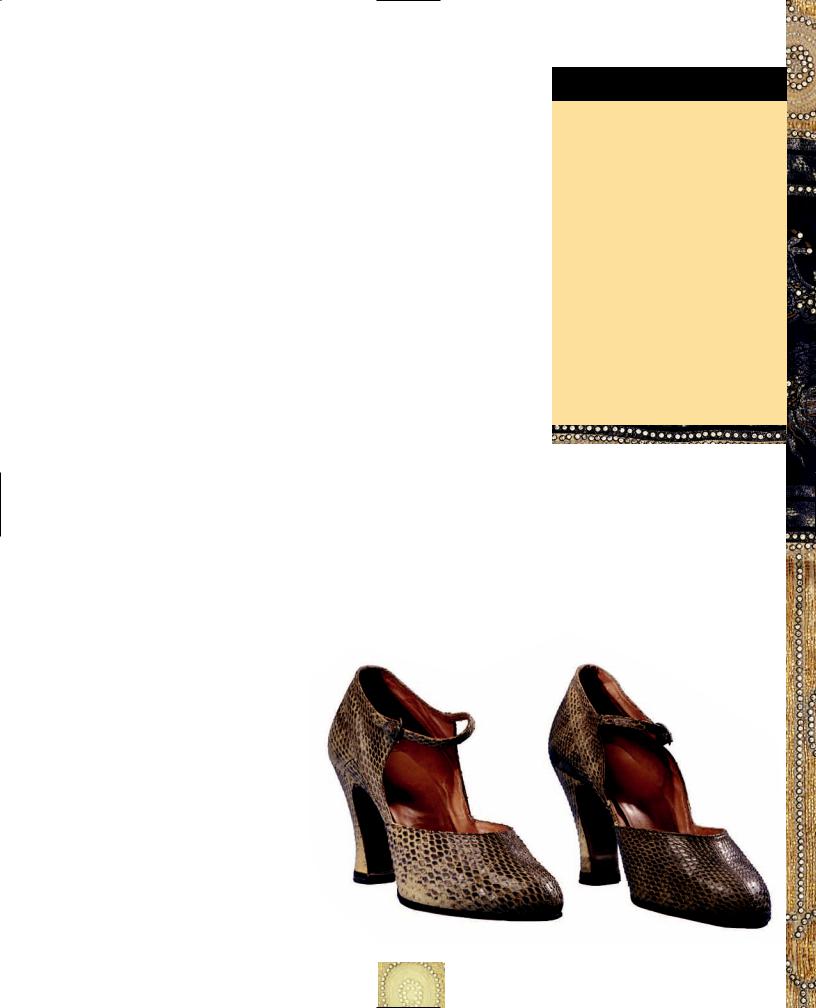
Clothes reflected the new mood of liberation in looser, lighter garments and with a simpler shape. Most dresses were tube-shaped and cut on the straight grain of the fabric, so they hung loosely and didn’t cling or follow the contours of the body. The typical 1920s silhouette was straight, boyish, flat-chested, and drop-waisted. It’s a great look but hard to live up to for anyone over the age of 25 and weighing more than 110 pounds, so costuming can be tricky.
W H A T W E N T U N D E R N E A T H
Underwear was as sheer as possible. Pantaloons were replaced by loosefitting cami-knickers or “cami-bockers,” a one-piece combination of “directoire” (knee-length) knickers and a chemise. Old-fashioned corsets, which had nipped in the waist and emphasized the hips, were abandoned in favor of a softer version that smoothed the hipline away. The ideal boyish figure needed no real support, and brassieres were little more than lace or cotton “bust bodices” that prevented wobbling, especially when dancing energetically. However, for those with a fuller figure, the fearsome-sounding Symington Side Lacer could help achieve a flatter chest. Today’s range of minimizer brassieres will achieve a similar effect with less discomfort, but in 1920, these were way in the future.
H I G H S O C I E T Y
Despite the revolution breaking around them, smart society, and the older generation in general, still dressed in accordance with the social calendar. They had new outfits for annual events such as the Saratoga or Ascot races and the Henley Regatta in the United Kingdom. Older and more conventional women still changed their outfits several times a day. They had a morning walking dress, an afternoon tea
dress, and evening wear for dinner or the theater. And they did mean, literally,
a dress: few women wore separates yet, and pants were frowned upon.
T H E F L A P P E R
The first image that comes to mind when you think of the 1920s has to be the “flapper” girls. The term didn’t just refer to their fashionable clothes; it described their unconventional attitudes and behavior. Flappers
drank and smoked cigarettes in public,
S T Y L E T I P
Don’t just wear the clothes—talk the talk. Flappers had their own language, designed to keep the older generation guessing when they were discussing what they were up to. “That’s the bee’s knees,” “the cat’s pajamas,” or even “that’s so Jake” meant “that’s great.” “Ab-so-lute-ly” was the only way to agree with somebody, but “none of your beeswax” meant “none of your business.” “Putting on the Ritz” was doing something in high style (after the Ritz Hotel in Paris).
Below: The neat ankle strap on these snakeskin shoes made sure they stayed on during the most hectic dancing.
7
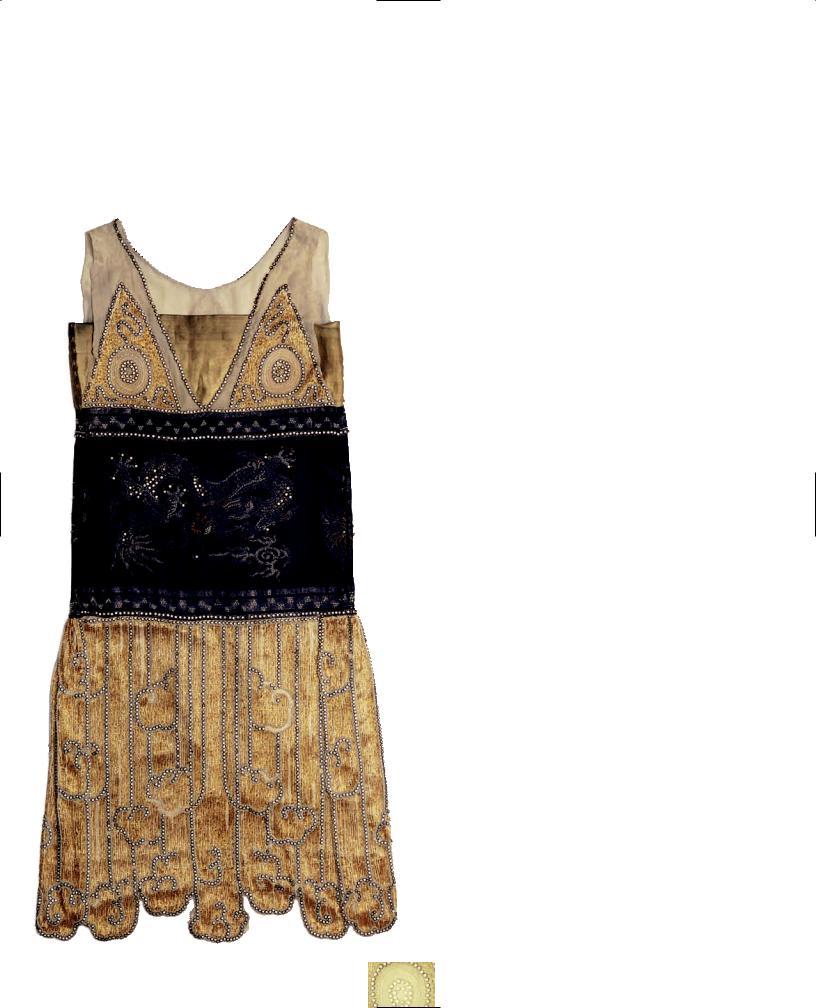
Below: This fabulous dress combines several typical features of the 1920s—glass beading,
a Chinese dragon motif, and a scalloped hem.
makeup, drove automobiles, and listened to jazz. The typical flapper look consisted of a sleeveless, loose-cut dress with a drop waist, reaching to mid-calf. Necklines could be V- or U-shaped or cut straight across the shoulders. Dresses were made from light, floaty fabrics such as chiffon, silk, or the new rayon and often had silk fringes that swung around as the wearer danced. Some were embroidered all over with tiny bugle beads
and sequins that caught the light during dancing. Other dresses just a panel of beaded fabric down the front. They were
with long strings of pearls and sheer stockings held up garters that could clearly be seen as the dress flew over knee in an energetic dance such as the Black Bottom. No
people were shocked!
Although there was a silent movie calledThe Flapper as as 1920, the real flapper era was between about 1925 1928. The hit TV series of the 1950s,The Roaring
wenties, featured Dorothy Provine as heart-of-gold nightclub entertainer Pinkie Pinkham, whose weekly new outfits were the highlight of the show.
The flapper look is easy to achieve because the shape itself is so simple—little more than two rectangles sewn at shoulder. It does depend, however, on the fabric.
ome 1920s fabrics had abstract patterns, but many were plain, enlivened with the addition of lace, fringes, beads, and sequins for detail. Go for a lightweight silk, silk georgette net, or chiffon for authenticity, but fine crepe is
more durable, especially if you’re planning beading or metal-thread embroidery. Panels of ready-made beading and sequins can be bought, ready to appliqué. Remember, though, that beading makes a dress quite heavy. The reason so few of these dresses have survived is that the chiffon and net were too flimsy to support the decoration, so they often tore.
H E M L I N E S
Not all 1920s dresses were short. Hemlines went up and down throughout the decade, so if you’re costuming a specific event, check the date carefully. Between 1920 and about 1924, calf length was the fashion, even for flappers. In the middle years, scalloped hems and handkerchief points disguised the fact that hemlines were steadily rising.
8

Close-fitting cloche hat
Bobbed hair barely visible under the hat
High fur-trimmed collar
Matching purse with clasp fastening
Hem at mid-calf length
Opaque silk or cotton stockings
Shoes with medium heel and multiple straps
1920s woman
Leather or kid gloves with stitching
Fur trim at the cuffs and hem
Dress just visible under the coat
9
